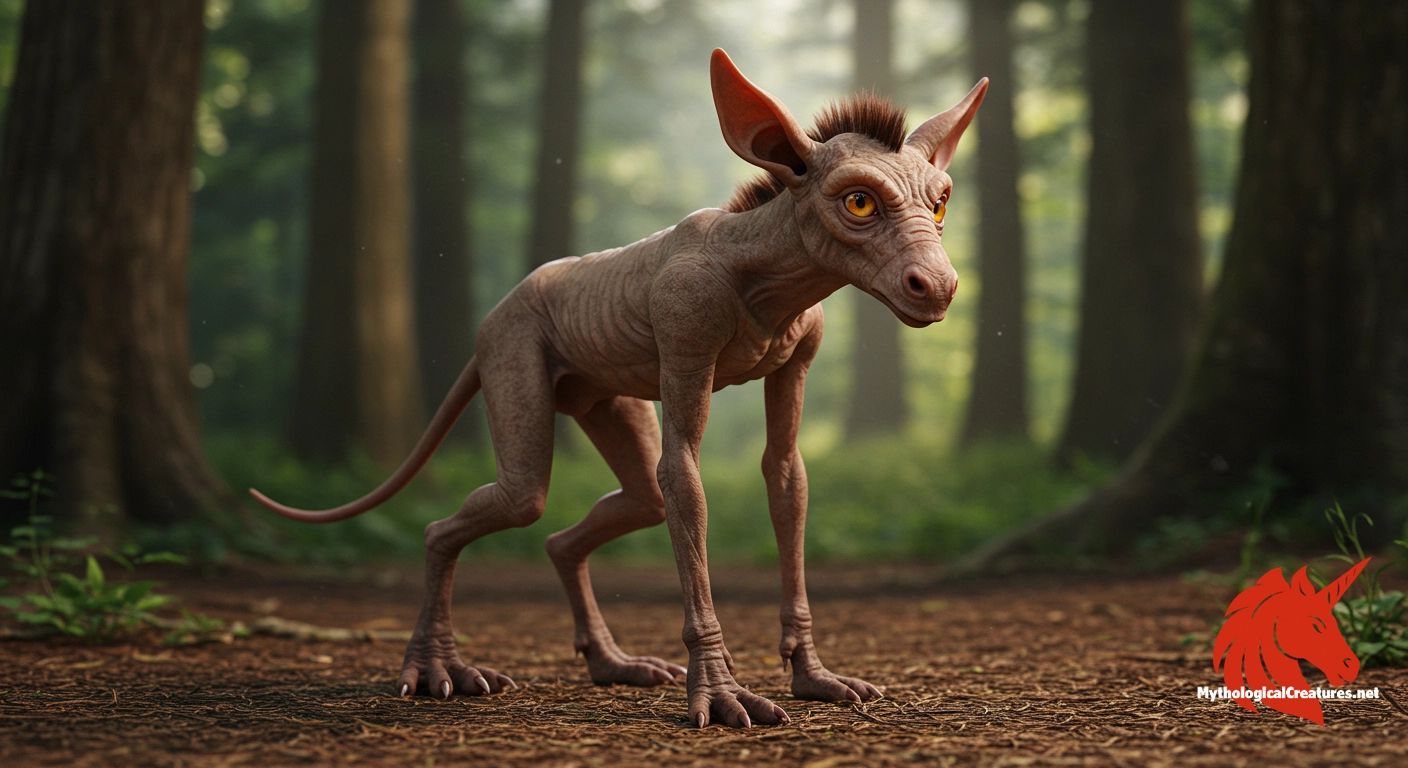Bieresel: The Bieresel is a mischievous house spirit rooted in German folklore, often associated with domestic settings and beer.

Bieresel
Bieresel - Regarded as a domestic protector with a humorous twist, the Bieresel embodies the capricious nature of household spirits in German myth.
Origins & First Encounters
The Bieresel is a captivating figure from German folklore that intricately weaves together the country's renowned beer culture with the enduring mystique of household spirits. Born from a tradition steeped in medieval customs, this creature is a distinct offshoot of the broader kobold myth, uniquely celebrated for its close ties with the brewing world. Its early appearances are lost in the mists of time, yet oral traditions and early manuscript references hint at its longstanding presence in domestic life. The very name 'Bieresel,' meaning 'beer donkey,' evokes vivid imagery and suggests a playful yet enigmatic guardian of the brew. It is often remembered in tales where the spirit was both a force of assistance and a harbinger of unpredictable luck, depending on how it was treated. Local lore from small German communities imbues the Bieresel with traits that bridge the gap between benevolence and mischievous intervention. The creature’s dual nature reflects the complexities of daily life in traditional brewhouses, where every element, even the unseen, was believed to influence success in brewing. Its legend has been passed down through generations, symbolising the interplay between human endeavours and otherworldly charm. Over time, the Bieresel has become a cultural emblem, representing the vibrant legacy of German domestic and festive traditions.
Source Texts & Tale Variants
The primary sources detailing the Bieresel are found within a rich tapestry of German folktales, compiled over many centuries and passed orally from one generation to the next. Early printed materials and manuscripts, dating back to the Renaissance period, contain fragmented yet evocative descriptions of this enigmatic spirit. These historical documents portray the creature as a minor, yet significant, presence in the daily lives of those who revered the art of brewing. Varied accounts in local manuscripts often recount how households offered small tokens of appreciation, such as a measure of beer, to appease the spirit and secure its favour. Alongside written records, regional ballads and narrative poems recount episodes of its intervention during both moments of prosperity and misfortune. Some versions even record the Bieresel as a friendly helper that once ensured the proper fermentation of a cherished brew, while others highlight its knack for mischief. The multiple spellings, including Biersal and Bierasal, found in differing texts underscore the fluidity and regional variation inherent in its legend. Over the centuries, folk stories documented in regional anthologies have helped preserve the quirky attributes and ambiguous morality of the Bieresel. These diverse sources not only enrich our understanding of this mythic being but also highlight its adaptability and enduring appeal in German cultural memory.
Form & Powers
The Bieresel is typically portrayed as a small, impish creature that blends both human and animal features in a singular form that reflects its dual nature. Its most striking feature is a pair of elongated, sensitive ears reminiscent of a donkey’s, which seem to twitch in harmony with its playful temperament. The creature is often depicted with a slightly elongated snout and bright, clever eyes that betray a capacity for mischief and whimsy. Although generally diminutive in stature, the Bieresel possesses a robust and agile build that allows it to dart nimbly about households and brewhouses. Some illustrations suggest an earthy skin tone or ruddy complexion, complementing its rustic origins and close association with nature. There are occasional references to a subtle covering of short, wiry fur which lends an otherworldly texture to its appearance. In various renditions, the creature might be shown wearing remnants of simple period attire, hinting at its integration into everyday domestic life. Its physical form, while modest, exudes an aura of ancient charm and mystery, balancing the familiar with the fantastical. This elaborate depiction underscores the myth’s deep interconnection with the cultural and natural landscapes from which it emerged.
Regional Faces
Across Germany, the Bieresel takes on various local flavours that reflect the diverse cultural landscapes of the region. In Bavaria, for instance, its image is deeply entwined with the traditions of local brewhouses and festive beer gardens, where it is seen as both a guardian and an emblem of good cheer. Regional narratives in the south often portray the creature as a benevolent custodian, appearing in moments of brewing or during communal celebrations to lend its unseen support. Meanwhile, in northern parts of Germany, the Bieresel is more frequently cast as a playful trickster whose antics serve as reminders to maintain proper household conduct. Variations in its depiction—ranging from subtle differences in physical traits to shifts in behavioural emphasis—reflect localized dialects and cultural nuances. In some rural communities, specific rituals or seasonal offerings are dedicated to appeasing this spirit, highlighting its importance in local tradition. These differing portrayals illustrate how the same mythic entity can adapt to varying social contexts and cultural expectations. The regional adaptations not only preserve the core myth but also enrich it with distinctive local colours and practices. Through these myriad expressions, the Bieresel stands as a unifying symbol, embodying the spirit of tradition while allowing for regional interpretation.
Cultural Parallels
The Bieresel shares intriguing similarities with household spirits and folkloric beings from across Europe, yet it remains uniquely defined by its affiliation with beer culture. When compared with figures like the British brownie, which similarly assists with domestic tasks in exchange for small gifts, the Bieresel’s association with the brewing craft sets it apart as a unique cultural signature. Its roots as a kobold align it with other Germanic sprites such as the Heinzelmännchen, while its distinctive traits resonate with the playful nature observed in other European domestic spirits. Parallel comparisons have even been drawn with the Irish leprechaun, both embodying aspects of luck, mischief, and protection within their local customs. Each of these creatures reflects the universal human desire to explain everyday occurrences with a touch of magic, yet the Bieresel stands out due to its specific link to the traditions of beer and brewing. This connection imbues the creature with an additional layer of symbolism that speaks to the cultural importance of craft and community in German history. Like its counterparts, it serves as a vessel for collective memory and a reminder of the mysteries that underpin daily life. The study of these cross-cultural similarities reveals both shared human experiences and unique regional expressions, with the Bieresel occupying a distinct niche in the folklore landscape. Its comparative analysis enriches our understanding of myth and the diverse ways in which societies celebrate the blurred lines between the natural and the supernatural.
Legacy & Modern Evolution
The portrayal of the Bieresel has transformed remarkably over the centuries, evolving from a mysterious and sometimes capricious household spirit into a beloved cultural icon. In early folklore, the creature was a symbol of both benevolence and unpredictable mischief, its presence seen as a double-edged blessing within the home and brewery alike. As modern times have approached, the Bieresel’s image has softened, leaning more towards the role of a warm, whimsical mascot celebrating the rich legacy of German brewing traditions. Many contemporary craft breweries and local festivals have embraced its iconography, using the creature’s distinct appearance to evoke a sense of heritage and communal pride. Artistic reinterpretations in literature, visual arts, and performance have recast the Bieresel into a figure that bridges the gap between antiquity and modernity. This reinvention has allowed the spirit to remain relevant, serving as a reminder of the enduring bond between folklore and everyday life. Modern consumers and enthusiasts revel in the myth’s quirky charm, often viewing it as a symbol of the spirited unpredictability inherent in creativity and tradition. The evolution of the Bieresel is a testament to the dynamic nature of myth, capable of absorbing new meanings while honouring its ancient roots. In this way, the creature continues to captivate and inspire, a living legend that endures in the hearts of those who cherish the interplay between myth and modern cultural identity.
Interesting Fact
One intriguing aspect of the Bieresel is its dual reputation as both a helpful domestic spirit and a mischief-maker, illustrating the complex relationship between humans and the supernatural in German folklore.
Quick Creature Info
Origin:
Features:
Associations:
Our Mythic Legendary Rating:

Also Sometimes Known As:
Habitat:
Supernatural Powers:
Physical Attributes:
Abilities:
Behavior:
Lore:
References
Discover Another Mythical Legend You May Not Have Heard Of?
Uncover the mysteries of ancient folklore and expand your knowledge of legendary beings from cultures around the world.
Dare to Meet the Shirime....
Curated by the Mythological Creatures Team (rev. May 2025)
